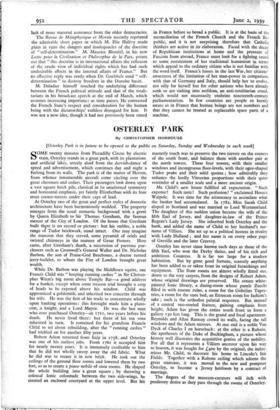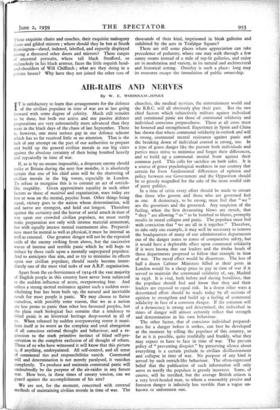OSTERLEY PARK
By CHRISTOPHER HOBHOUSE
[Osterley Park is in future to be opened to the public on Saturday, Sunday and Wednesday in each week] SOME twenty minutes from Piccadilly Circus by electric train, Osterley stands in a great park, with its plantations and artificial lakes, utterly aloof from the dervish-dance of speed and advertisement, which continues day and night a furlong from its walls. The park is of the manor of Heston, from whence innumerable aircraft come circling over the great chestnuts and cedars. Their passengers look down upon a vast square brick pile, classical in its unadorned symmetry and horizontal emphasis, yet faintly Elizabethan with its four stout corner-turrets under their caps of lead.
At Osterley two of the great and perfect styles of domestic architecture have been harmoniously wedded. The property emerges from the usual monastic background with a grent by Queen Elizabeth to Sir Thomas Gresham, the famous mercer of the City of London. Of the house that Gresham built thcre is no record or picture: but his stables, a noble range of Tudor brickwork, stand intact. One may imagine the mansion that they served, some pyramid of oriels and twisted chimneys in the manner of Great Fosters. Here came, after Gresham's death, a succession of parvenu pur- chasers such as Cromwell's General Waller and Dr. Nicholas Barbon, the son of Praise-God Barebones, a doctor turned jerry-builder, to whom the Fire of London brought great wealth.
While Dr. Barbon was playing the Middlesex squire, one Francis Child was " keeping running cashes " in Sir Christo- pher Wren's big room above Temple Bar—a good address for a banker, except when some treason trial brought a crop of heads to be exposed above his window. Child was apprenticed a goldsmith, and inherited two concerns through his wife. He was the first of his trade to concentrate wholly upon banking operations: this foresight made him a pluto- crat, a knight, and a Lord Mayor. He was the last man who ever purchased Osterley—in 1711, two years before his death. He never lived there: but three of his ten sons inherited in turn. It remained for his grandson Francis Child to set about rebuilding, after the " running cashes " had trickled on for another fifty years.
Robert Adam returned from Italy in 1758, and Osterley was one of his earliest jobs. From 1761 it occupied him for nearly twenty years. It is immensely creditable to him that he did not wholly sweep away the old fabric. What he did was to recase it in new brick. He took out the ceilings of the ground floor rooms and lowered them by two feet, so as to create a piano nobile of state rooms. He shaped the whole building into a great square ; by throwing a colossal Ionic colonnade between the two side-wings, he created an enclosed courtyard at the upper level. But his masterly touch was to preserve the two turrets on the corners of the south front, and balance them with another pair at the north towers. These four towers, with their smaller windows and incongruous floor-levels, with their ogee-shaped Tudor peaks and their solid quoins ; how admirably they enhance the lordly Vitruvian proportions with their quiet reminder of a smaller scale and a more ancient origin.
Mr. Child's new house fulfilled all expectation. " Such expense! Such taste! Such profusion! " exclaimed Horace Walpole. It was time for the aristocracy to assimilate what the banker had accumulated. In 1782, Miss Sarah Child eloped to Scotland and was married to Lord Westmorland. The daughter of this sudden union became the wife of the fifth Earl of Jersey, and daughter-in-law of the Prince Regent's Lady jersey. She inherited both Osterley and the bank, and added the name of Child to her husband's sur- name of Villiers. She set up as a political hostess in rivalry with Lady Holland ; and her name is on every other page of Greville and the later Creevey.
Osterley has never since known such days as those of the fifth Earl, who won the Derby thrice, and of his rich and ambitious Countess. It is far too large for a modern habitation. But by great good fortune, scarcely anything has been added to or taken from its original furnishings and equipment. The State rooms are almost wholly fitted out, down to the very carpets, from the designs of Robert Adam, whose original drawings are preserved. His ornate white- painted Ionic library, a dining-room whose panels Zucchi filled in with roseate ruins, a room for the Gobelins Tapes- tries, a room for the state bed, an Etruscan room for fashion's sake ; such is the orthodox palatial sequence. But instead of a central two-storied feature, gaining emphasis from height, Adam has given the entire south front to form a gallery 13o feet long. This is the grand and focal apartment. Reynolds and Allan Ramsay crowd its walls, facing the tall windows and the Adam mirrors. At one end is a noble Van Dyck of Charles I on horseback: at the other is a Rubens, the apotheosis of the Duke of Buckingham, a picture whose history well illustrates the acquisitive genius of the nobility. For all that it represents a Villiers ancestor upon his way to heaven, it was bought for £400 by the original, the indus- trious Mr. Child, to decorate his home in Lincoln's Inn Fields. Together with a Rubens ceiling which adorns the great staircase, it was moved to the new and pompous Osterley, to become a Jersey heirloom by a contract of marriage.
The fingers of the museum-curators will itch with predatory desire as they pass through the rooms of Osterley. These exquisite chairs and couches, their exquisite mahogany doors and gilded mirrors ; where should they be but at South Kensington—dated, indexed, labelled, and expertly displayed among a thousand other doors and mirrors? These ranges of ancestral portraits, where tall black Strafford, so melancholy in his black armour, faces the little roguish head- and-shoulders of Will Chiffinch ; what are they doing in a private house? Why have they not joined the other tens of thousands of their kind, imprisoned in bleak galleries and exhibited by the acre in Trafalgar Square?
There are still some places where appreciation can take precedence of pedantry, where one may walk through a few sunny rooms instead of a mile of top-lit galleries, and enjoy art in moderation and variety, in its natural and architectural and historical setting. Osterley is such a place: long may its treasures escape the immolation of public ownership.











































 Previous page
Previous page